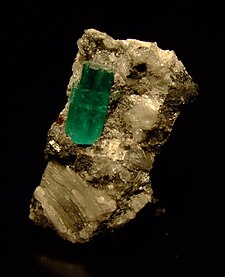Emeralds
| Emerald | |
|---|---|

|
|
| General | |
| Category | Beryl variety |
|
Formula (repeating unit) |
Be3Al2(SiO3)6 |
| Crystal system | Hexagonal (6/m 2/m 2/m) Space group: P6/mсc |
| Space group | (6/m 2/m 2/m) – Dihexagonal Dipyramidal |
| Unit cell | a = 9.21 Å, c = 9.19 Å; Z = 2 |
| Identification | |
| Formula mass | 537.50 |
| Color | Green shades to colorless |
| Crystal habit | Massive to well Crystalline |
| Cleavage | Imperfect on the [0001] |
| Fracture | Conchoidal |
| Mohs scale hardness | 7.5–8 |
| Luster | Vitreous |
| Streak | White |
| Diaphaneity | Transparent to opaque |
| Specific gravity | Average 2.76 |
| Optical properties | Uniaxial (-) |
| Refractive index | nω = 1.564–1.595, nε = 1.568–1.602 |
| Birefringence | δ = 0.0040–0.0070 |
| Ultraviolet fluorescence | None (some fracture filling materials used to improve emerald's clarity do fluoresce, but the stone itself does not) |
| References | |
Emerald is a gemstone and a variety of the mineral beryl (Be3Al2(SiO3)6) colored green by trace amounts of chromium and sometimes vanadium. Beryl has a hardness of 7.5–8 on the Mohs scale. Most emeralds are highly included, so their toughness (resistance to breakage) is classified as generally poor. Emerald is a cyclosilicate.
The word "emerald" is derived (via Old French: esmeraude and Middle English: emeraude), from Vulgar Latin: esmaralda/esmaraldus, a variant of Latin smaragdus, which originated in Ancient Greek: σμάραγδος (smaragdos; "green gem").
Emeralds, like all colored gemstones, are graded using four basic parameters–the four Cs of Connoisseurship: Color, Clarity, Cut and Carat weight. Before the 20th century, jewelers used the term water, as in "a gem of the finest water", to express the combination of two qualities: color and clarity. Normally, in the grading of colored gemstones, color is by far the most important criterion. However, in the grading of emeralds, clarity is considered a close second. A fine emerald must possess not only a pure verdant green hue as described below, but also a high degree of transparency to be considered a top gem.
In the 1960s, the American jewelry industry changed the definition of "emerald" to include the green vanadium-bearing beryl as emerald. As a result, vanadium emeralds purchased as emeralds in the United States are not recognized as such in the UK and Europe. In America, the distinction between traditional emeralds and the new vanadium kind is often reflected in the use of terms such as "Colombian Emerald".
...
Wikipedia
